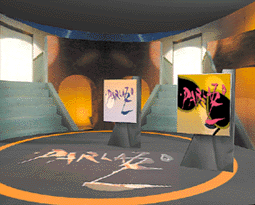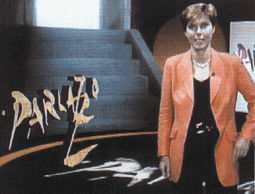

A virtual set in combination with live video

by Simon Gibbs and Ulrich Nütten
In order to remain competitive today, television broadcasters must cut the costs of production at all levels. Particularly expensive are studios, back-drops, and lighting systems. With ultramodern visualization systems, however, deceptively authentic-looking studio environments can be generated on a computer screen. These systems make producers more productive, and hence more competitive, while opening up entirely new visual possibilities.
Together with Deutsche Welle Cologne and its spin-off company "Horz & Schnepf", GMD is developing a prototyp system for the generation of virtual back-drops and artificial lighting. This system is being integrated into a professional studio and mixing environment.
In television practice, video materials from different sources are often blended into a single image. Until recently, however, camera movements in one component of a composite image, such as panning and zooming, could not be mirrored in the others. Producers typically have worked around this problem by anchoring the camera in a fixed position and orientation. A well-known example of this is the weather report, in which the images of the speaker and the weather map are taken from a fixed camera angle. In Virtual Studios, a digital mixer combines the image from a real camera with virtual back-drops and virtual props - 3D-objects generated and realistically rendered by a graphics computer. The appearance of these virtual objects is determined by the position, orientation, zoom, and focus of the real camera. Ideally, the virtual objects must be adjusted to the real camera settings and blended with the real video images so flowlessly that the viewer detects no discontinuity.


To achieve this - to allow the camera to move - is to overcome one of the main limitations of today's mixing techniques. That virtual props and back-drops consist of 3D-objects which are manipulable at will. This gives them important advantages over physical objects: their color, form, and surface can be changed easily;they can be switched at the touch of a button; and their surfaces can display yet other graphics or video images. Virtual back-drops and props, moreover, need not continually be set up and taken down or stored in expensive warehouses.
The technical environment of the studio consists of a tracking device that senses the position, orientation, zoom, and focus of the camera; a SGI Onyx workstation for generating the adapting the virtual back-drops and a Ultimatte 7 mixer for blending the artificial images with the real.